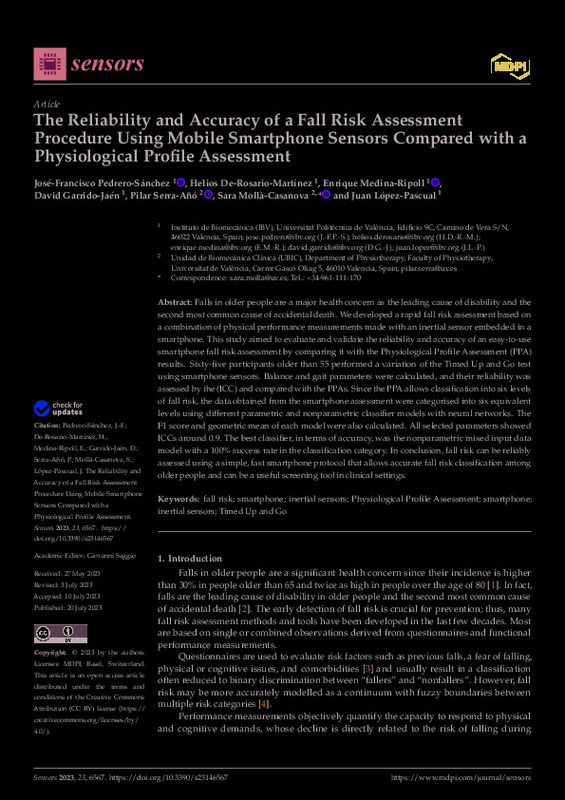JavaScript is disabled for your browser. Some features of this site may not work without it.
Buscar en RiuNet
Listar
Mi cuenta
Estadísticas
Ayuda RiuNet
Admin. UPV
The Reliability and Accuracy of a Fall Risk Assessment Procedure Using Mobile Smartphone Sensors Compared with a Physiological Profile Assessment
Mostrar el registro sencillo del ítem
Ficheros en el ítem
| dc.contributor.author | PEDRERO, J.F.
|
es_ES |
| dc.contributor.author | De Rosario Martínez, Helios
|
es_ES |
| dc.contributor.author | Medina Ripoll, Enrique
|
es_ES |
| dc.contributor.author | Garrido Jaen, Jose David
|
es_ES |
| dc.contributor.author | Serra-Añó, Pilar
|
es_ES |
| dc.contributor.author | Mollà-Casanova, Sara
|
es_ES |
| dc.contributor.author | Lopez Pascual, Juan
|
es_ES |
| dc.date.accessioned | 2024-02-22T19:02:00Z | |
| dc.date.available | 2024-02-22T19:02:00Z | |
| dc.date.issued | 2023-07 | es_ES |
| dc.identifier.uri | http://hdl.handle.net/10251/202746 | |
| dc.description.abstract | [EN] Falls in older people are a major health concern as the leading cause of disability and the second most common cause of accidental death. We developed a rapid fall risk assessment based on a combination of physical performance measurements made with an inertial sensor embedded in a smartphone. This study aimed to evaluate and validate the reliability and accuracy of an easy-to-use smartphone fall risk assessment by comparing it with the Physiological Profile Assessment (PPA) results. Sixty-five participants older than 55 performed a variation of the Timed Up and Go test using smartphone sensors. Balance and gait parameters were calculated, and their reliability was assessed by the (ICC) and compared with the PPAs. Since the PPA allows classification into six levels of fall risk, the data obtained from the smartphone assessment were categorised into six equivalent levels using different parametric and nonparametric classifier models with neural networks. The F1 score and geometric mean of each model were also calculated. All selected parameters showed ICCs around 0.9. The best classifier, in terms of accuracy, was the nonparametric mixed input data model with a 100% success rate in the classification category. In conclusion, fall risk can be reliably assessed using a simple, fast smartphone protocol that allows accurate fall risk classification among older people and can be a useful screening tool in clinical settings. | es_ES |
| dc.description.sponsorship | Activity developed within the framework of several fundings: i. CERVERA Network financed by the Ministry of Science and Innovation through the Center for Industrial Technological Development charged to the General State Budgets 2021, and the Recovery, Transformation, and Resilience Plan (CER20211003); ii. State Plan for Scientific and Technical Research and Innovation (Knowledge Generation) co-financed by EU FEDER funds (PID2021-125694OB-I00); iii. Consolidated research groups program from Generalitat Valenciana, Conselleria d¿Innovació, Universitats, Ciència i Societat: CIAICO/2021/215; iv. Talent attraction program from Universitat de València (INV19-01-13-07). | es_ES |
| dc.language | Inglés | es_ES |
| dc.publisher | MDPI AG | es_ES |
| dc.relation.ispartof | Sensors | es_ES |
| dc.rights | Reconocimiento (by) | es_ES |
| dc.subject | Fall risk | es_ES |
| dc.subject | Smartphone | es_ES |
| dc.subject | Inertial sensors | es_ES |
| dc.subject | Physiological Profile Assessment | es_ES |
| dc.subject | Timed Up and Go | es_ES |
| dc.title | The Reliability and Accuracy of a Fall Risk Assessment Procedure Using Mobile Smartphone Sensors Compared with a Physiological Profile Assessment | es_ES |
| dc.type | Artículo | es_ES |
| dc.identifier.doi | 10.3390/s23146567 | es_ES |
| dc.relation.projectID | info:eu-repo/grantAgreement/AEI/Plan Estatal de Investigación Científica y Técnica y de Innovación 2021-2023/PID2021-125694OB-I00/ES/SISTEMA ROBOTICO PARALELO CON CONTROL BASADO EN MODELO MUSCULO-ESQUELETICO PARA LA MONITORIZACION Y ENTRENAMIENTO DEL SISTEMA PROPIOCEPTIVO/ | es_ES |
| dc.relation.projectID | info:eu-repo/grantAgreement/UV//INV19-01-13-07/ | es_ES |
| dc.relation.projectID | info:eu-repo/grantAgreement/CIUCSD//CIAICO%2F2021%2F215/ | es_ES |
| dc.rights.accessRights | Abierto | es_ES |
| dc.contributor.affiliation | Universitat Politècnica de València. Instituto Universitario Mixto de Biomecánica de Valencia - Institut Universitari Mixt de Biomecànica de València | es_ES |
| dc.description.bibliographicCitation | Pedrero, J.; De Rosario Martínez, H.; Medina Ripoll, E.; Garrido Jaen, JD.; Serra-Añó, P.; Mollà-Casanova, S.; Lopez Pascual, J. (2023). The Reliability and Accuracy of a Fall Risk Assessment Procedure Using Mobile Smartphone Sensors Compared with a Physiological Profile Assessment. Sensors. 23(14). https://doi.org/10.3390/s23146567 | es_ES |
| dc.description.accrualMethod | S | es_ES |
| dc.relation.publisherversion | https://doi.org/10.3390/s23146567 | es_ES |
| dc.type.version | info:eu-repo/semantics/publishedVersion | es_ES |
| dc.description.volume | 23 | es_ES |
| dc.description.issue | 14 | es_ES |
| dc.identifier.eissn | 1424-8220 | es_ES |
| dc.identifier.pmid | 37514860 | es_ES |
| dc.identifier.pmcid | PMC10385364 | es_ES |
| dc.relation.pasarela | S\497744 | es_ES |
| dc.contributor.funder | Universitat de València | es_ES |
| dc.contributor.funder | Agencia Estatal de Investigación | es_ES |
| dc.contributor.funder | European Regional Development Fund | es_ES |
| dc.contributor.funder | Conselleria de Innovación, Universidades, Ciencia y Sociedad Digital, Generalitat Valenciana | es_ES |








